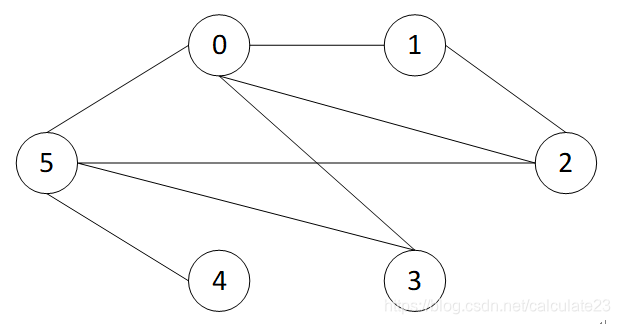版权声明:Please work hard for your dreams. https://blog.csdn.net/calculate23/article/details/89185738
实验十二、无向图的邻接矩阵存储及广度优先搜索遍历
1 实验目的
本实验实现无向图的邻接矩阵存储,并输出邻接矩阵, 以及该无向图的广度优先遍历序列。
2 实验内容
- 建立如图所示的无向图G的邻接矩阵,并输出该矩阵。

- 输出广度优先遍历序列
Code:
#include<stdio.h>
#include<stdlib.h>
#include<windows.h>
#define MAX_SIZE 20
#define OK 1
#define NO 0
#define INF 0x3f3f3f3f
typedef int Status;
typedef int ElemType;
typedef char InfoType;
typedef struct
{
InfoType *info;
ElemType Vertex;
}ArcCell,ImageTable[MAX_SIZE][MAX_SIZE];
typedef struct
{
ImageTable Matrix; //临接矩阵
ArcCell vexs[MAX_SIZE]; //顶点表
int vexnum,arcnum; //统计顶点和边(弧)的个数
Status Tag; //图的种类 1,2,3,4分别对应无向图、无向网、有向图、有向网
}MGraph;
//以下链队列
typedef struct QNode
{
ElemType data;
struct QNode *next;
}QueueNode,*QueuePoint;
typedef struct
{
int QueueSize;
QueuePoint front;
QueuePoint rear;
}QueueHead,*QueueHeadPoint;
QueueHeadPoint InitQueue()
{
QueueHeadPoint Head=(QueueHeadPoint)malloc(sizeof(QueueHead));
Head->QueueSize=0;
Head->front=Head->rear=(QueuePoint)malloc(sizeof(QueueNode));
Head->rear->next=NULL;
return Head;
}
Status QueueEmpty(QueueHeadPoint Head)
{
if(Head->front == Head->rear)
return OK;
return NO;
}
ElemType getFront(QueueHeadPoint *Head)
{
if(QueueEmpty(*Head))
return NULL;
return (*Head)->front->next->data;
}
Status QueuePush(QueueHeadPoint *Head,ElemType data)
{
QueuePoint p=(QueuePoint)malloc(sizeof(QueueNode));
if(p==NULL)
{
printf("对不起,系统内存不足!入栈失败!\n");
return NO;
}
p->data=data;
p->next=(*Head)->rear->next;
(*Head)->rear->next=p;
(*Head)->rear=p;
(*Head)->QueueSize++;
return OK;
}
Status QueuePop(QueueHeadPoint *Head)
{
QueuePoint p=(*Head)->front;
if(QueueEmpty(*Head))
return NO;
(*Head)->front=p->next;
(*Head)->QueueSize--;
free(p);
return OK;
}
Status QueueDelete(QueueHeadPoint *Head)
{
while(!QueueEmpty(*Head))
QueuePop(Head);
free((*Head)->front);
return OK;
}
//以上为链队列
Status CreatUDG(MGraph *Node)
{
int i,j,v1,v2;
Node->Tag=1;
Node->arcnum=Node->vexnum=0;
for(i=0;i<MAX_SIZE;i++)
{
Node->vexs[i].Vertex=0;
for(j=0;j<MAX_SIZE;j++)
Node->Matrix[i][j].Vertex=0;
}
while(scanf("%d%d",&v1,&v2)!=EOF && v1>=0 && v2>=0)
{
if(v1>=MAX_SIZE || v2>=MAX_SIZE)
{
printf("输入数据超出矩阵能容纳的最大值!请重新输入\n");
system("peuse");
}
else
{
Node->Matrix[v1][v2].Vertex=Node->Matrix[v2][v1].Vertex=1;
if(Node->vexs[v1].Vertex==0 && Node->vexs[v2].Vertex==0)
{
Node->vexs[v1].Vertex=Node->vexs[v2].Vertex=1;
Node->vexnum+=2;
}
else if(Node->vexs[v1].Vertex==0)
{
Node->vexs[v1].Vertex=1;
Node->vexnum++;
}
else if(Node->vexs[v2].Vertex==0)
{
Node->vexs[v2].Vertex=1;
Node->vexnum++;
}
else
continue;
Node->arcnum++;
}
}
return OK;
}
Status BFS(MGraph *Node,ElemType start)
{
QueueHeadPoint Head=InitQueue();
int flag[MAX_SIZE],now,i;
QueuePush(&Head,start);
for(i=0;i<MAX_SIZE;i++)
flag[i]=0;
printf("广度优先遍历:\n");
printf("%d ",start);
flag[start]=1;
while(!QueueEmpty(Head))
{
now=getFront(&Head);
QueuePop(&Head);
for(i=0;i<MAX_SIZE;i++)
{
if(Node->Matrix[now][i].Vertex==1 && flag[i]==0)
{
printf("%d ",i);
QueuePush(&Head,i);
flag[i]=1;
}
}
}
printf("\n");
QueueDelete(&Head);
return OK;
}
int main()
{
MGraph image;
int i,j;
CreatUDG(&image);
/* Output MGraph:
for(i=0;i<6;i++)
for(j=0;j<6;j++)
printf("%d%c",image.Matrix[i][j].Vertex," \n"[j==5]);
*/
BFS(&image,0);
return 0;
}
/**
input:
0 1
0 2
0 3
0 5
1 2
2 5
3 5
4 5
-1 -1
*/